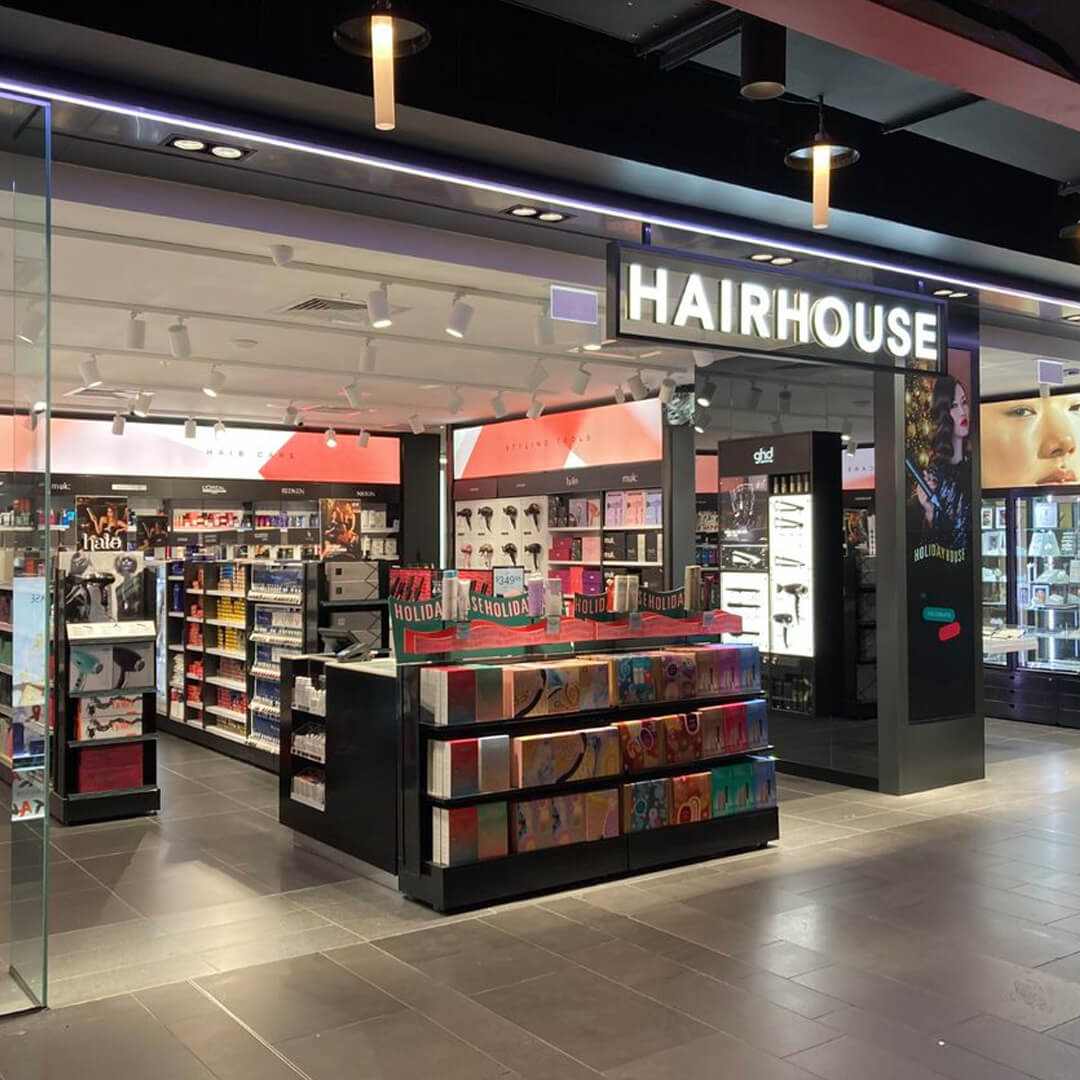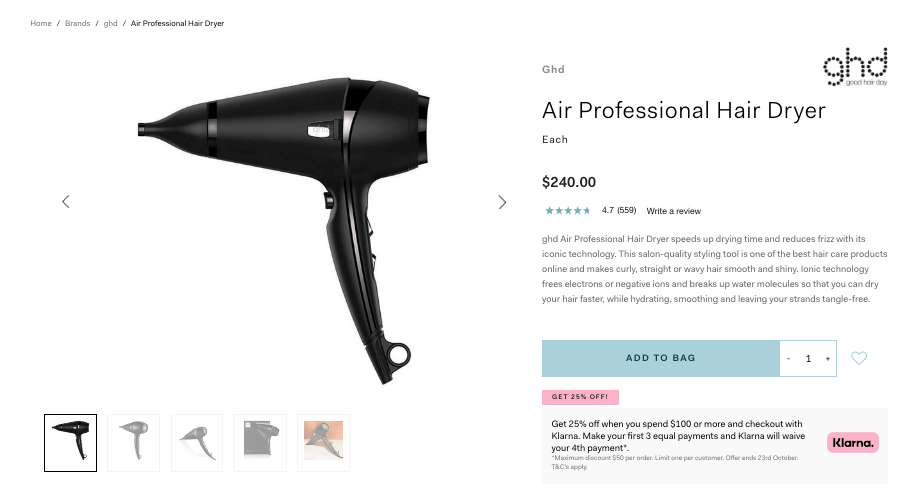Hairhouse Australia verkauft seine Haar- und Beauty-Produkte sowohl online als auch in Filialen in ganz Australien. Das Unternehmen führt über 4.500 Produkte von über 90 verschiedenen Marken. Aktuell vollzieht Hairhouse für seine digitalen Plattformen und im Einzelhandel ein umfassendes Rebranding. Neben der Modernisierung der Internetpräsenz will das Unternehmen damit ein stärker auf jüngere Verbraucher ausgerichtetes digitales Shopping-Erlebnis schaffen und seine Konversionsraten steigern.

Hairhouse Store
Darüber hinaus wollte das Team die Anzahl der Beurteilungen und Bewertungen auf Produktseiten erhöhen, um Kunden die Kaufentscheidung weiter zu erleichtern.
„Die Kunden sind heute besser informiert“, so Ash Mehta, Head of Digital & Technology bei Hairhouse. „Sie treffen gerne fundierte Entscheidungen auf der Grundlage ihrer eigenen Recherche.“
Vor der Umgestaltung nutzte Hairhouse einen beliebten Anbieter von Bewertungen. Leider ging aber nicht die erhoffte Anzahl von Bewertungen ein. Das Unternehmen stellte fest, dass es schwierig war, die Reichweite seiner Produkte und Dienstleistungen auszuweiten. Das Team wusste, dass es an der Zeit war, etwas zu ändern, und führte daher Bazaarvoice ein, um die Anzahl an Bewertungen über die digitalen Plattformen hinweg zu erhöhen.
„Bazaarvoice ermöglicht es uns, Kundenfeedback zu sammeln und unterstützt Kunden, die die Bewertungen lesen, bei ihren Kaufentscheidungen“, so Mehta.
Ein Follow-up nach dem Kauf führt zu mehr Bewertungen
Hairhouse führte Ratings & Reviews von Bazaarvoice in seinem E-Commerce-Shop ein. Um das Volumen an Bewertungen zu erhöhen, arbeitete das Unternehmen mit Bazaarvoice zusammen, um E-Mails mit Bewertungsanfragen zu erstellen, die einige Wochen nach dem Kauf an Kunden gesendet werden.
Auch Kunden im stationären Handel erhielten zum Teil entsprechende E-Mail-Anfragen nach ihrem Einkauf. Hier konzentrierte man sich auf die Kunden, die bereits beim Treueprogramm angemeldet waren und daher ihre Kontaktinformationen bereitgestellt hatten.
„Die meisten Bewertungen, die wir erhalten haben, sind recht positiv, und wir haben festgestellt, dass andere Kunden diese Bewertungen tatsächlich lesen, bevor sie einkaufen“, so Mehta.
Diese Bemühungen zur Erstellung von Bewertungen waren äußerst erfolgreich. Tatsächlich erhielt das Unternehmen so viel Content, dass das Team bald nach einer Möglichkeit suchte, Kunden einen schnelleren Überblick über die grobe Tendenz der Bewertungen zu geben. Hierfür implementierte man schließlich die Lösung „Review Highlights“.
„Wenn Sie Bewertungen sammeln, möchten Sie sie auch zeigen. Auf Seiten, auf denen wir viele Bewertungen haben, können Kunden anhand von Bewertungs-Highlights leichter erkennen, dass es sich bei einem Artikel um ein vertrauenswürdiges Produkt handelt“, so Mehta.
Darüber hinaus nutzt Hairhouse die Review Highlights, um Produkte nach Kundenfeedback anzupassen oder entsprechende Hinweise an den Hersteller weiterzuleiten.
Hairhouse nutzt auch auf anderen Seiten seines E-Commerce-Shops Bewertungen, die herausstechen. Das Unternehmen hat bestimmte Kategorieseiten auf seiner Website, auf denen eine bestimmte Marke oder Produktkategorie hervorgehoben wird. Hairhouse hat begonnen, Zitatausschnitte aus Bewertungen auf relevanten Kategorieseiten anzuzeigen, um neuen Käufern die Glaubwürdigkeit der Bewertungen („Social Proof“) zu verdeutlichen.
Anstieg der Konversionsraten um 35 % auf Seiten mit Bewertungen
Durch die Zusammenarbeit mit Bazaarvoice konnte das Hairhouse-Team Zeit sparen und die Anzahl der Bewertungen und die Konversionsraten steigern. Tatsächlich konnte Hairhouse die Konversionsrate auf Seiten mit Bewertungen und Highlights um 35 % steigern, im Vergleich zu Produktseiten ohne Bewertungen oder Highlights. Außerdem wurde auf Seiten mit Bewertungen und Bewertungs-Highlights ein Anstieg des durchschnittlichen Bestellvolumens von 15 % verzeichnet.
„Was uns wirklich gefällt, ist, dass die Bewertungen von Bazaarvoice kuratiert werden, sodass wir dies nicht tun müssen“, so Mehta. „Das spart auf jeden Fall viel Zeit.“

Quelle: hairhouse.com.au
Hairhouse arbeitet derzeit mit seinem Bazaarvoice-Team an der Optimierung seiner E-Mail-Strategie für zukünftige Bewertungsanfragen.
„Wir schauen uns an, wie das Timing verbessert werden kann, beziehungsweise wie die E-Mail basierend auf der tatsächlichen Lieferung des Produkts getriggert werden kann, anstatt die E-Mail nach sechs Wochen nach dem Zufallsprinzip zu senden“, so Mehta.
Die Anpassungen, die Hairhouse bisher hat durchführen lassen, haben geholfen, eine beträchtliche Menge neuer Bewertungen zu generieren. Hairhouse profitiert auch vom größeren Bazaarvoice-Netzwerk und nutzt Syndication. Etwa 54 % des Volumens an Bewertungen des Unternehmens stammen aus syndizierten Bewertungen von 29 Lieferanten. Hairhouse möchte die Zusammenarbeit mit Bazaarvoice in Zukunft gerne noch erweitern, um eine große Menge an Bewertungen für neuere Produkte zu erhalten.
„Bazaarvoice hilft uns dabei, Bewertungen auf Produktseiten zu nutzen, damit Kunden bessere Entscheidungen treffen können“, so Mehta. „Wir denken aber immer darüber nach, was wir sonst noch tun können. In Zukunft werden wir versuchen, die Anzahl der Bewertungen, die wir erhalten, zu erhöhen und herauszufinden, wie wir sie auch auf anderen Kanälen nutzen können.“
Erfahren Sie mehr darüber, wie Beurteilungen und Bewertungen Ihre Marke dabei unterstützen können, die Konversionsrate und den Umsatz zu steigern. Oder fordern Sie hier eine Demoversion an.






